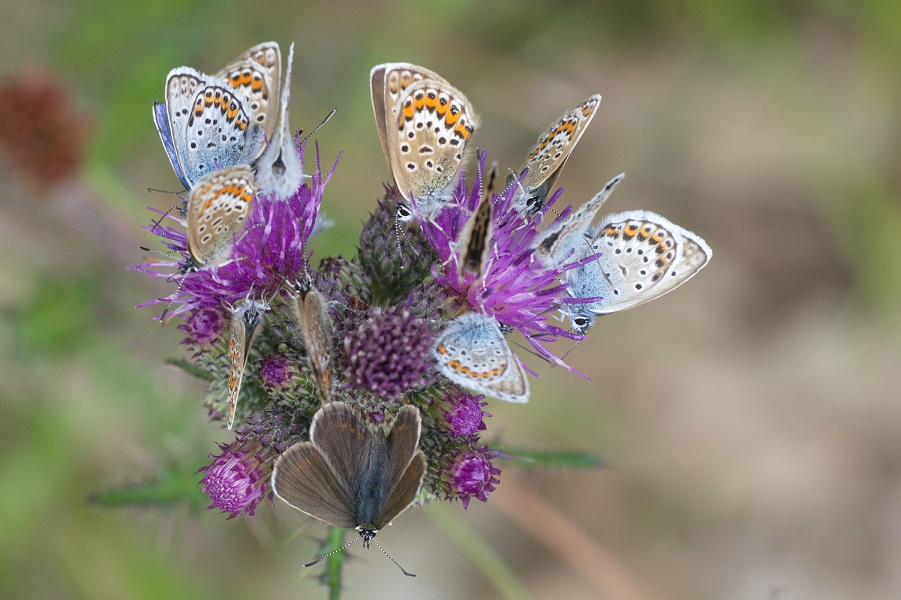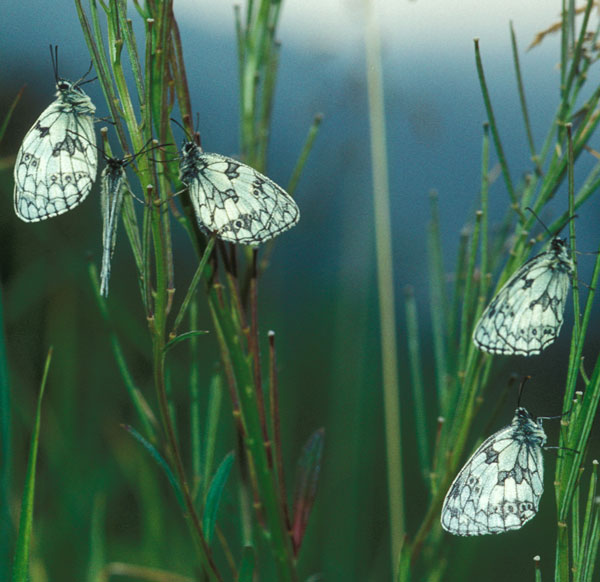|
5. Behaviour of butterflies
Butterflies appear in some cases to live alone but some species behave socially. There are species that collaborate in the larval stage. In the mating period the adults display various manners to make contact. Landscape shape and landmarks may play an important role in orientation and communication.
Butterflies use landmarks as orientation, particularly when they are looking for a mate. In this way they are not unique, bees and wasps can read patterns in landscape and vegetation even more precisely. That is understandable, these insects must return to their nests accurately in order to look after their grubs. In the case of butterflies the goal is to find a mate at great distance and a good place for egg-laying.
The possibilities in a butterfly for a complicated search behaviour depends much on its longevity. Short living butterflies have no chance to learn to recognize the landscape or for a complicated courtship, whereas long living butterflies have many possibilities for orientation within the landscape and for exhausting courtship rituals. After hatching, these butterflies start with foraging, leaving the place of emergence before the search for a mate dominates their behaviour.
Landmarks
Males which like to aggregate look for a remarkable point in the landscape such as a hilltop, master tree or identifiable spot. Well known is the swallowtail (Papilio machaon) for its hilltopping behaviour. Solitary individuals use such things as a spot or use an edge to move along. The latter can be observed during spring in males of the brimstone (Gonepteryx rhamni) flying up and down along a woodland edge or in the garden along a row of shrubs.
Congener
In some species of butterflies both sexes gather on spots to drink on moist soil or they stay together during the night in a dormitory. This aggregation behaviour may have different meanings but one is easy to understand; butterflies which possess a chemical defence profit when they are together; they will have a better chance of escaping from predators, which will learn that butterflies of a certain appearance are inedible. Well-known are the sleeping marbled whites (Melanargia galathea) for their conspicuous presence on the selected site. In America the monarch (Danaus plexippus) hibernates in huge masses in the mountain forests of Mexico and California. Though mortality by night frosts will occur, this gathering behaviour must have a credit balance.
|
 |
Photograph (left): Melanargia galathea. Frits Bink ©.
A remarkable phenomenon is the congregation behaviour, especially when they assemble before passing the night.
The marbled white (Melanargia galathea) likes a dormitory in tall grass,
the silver-studded blue (Plebejus argus) gathering at the end of the afternoon on a flowering thistle.
Photograph (right): Plebejus argus. Jeroen Voogd ©.
|
Courtship
There is a great variation in courtship behaviour. In many species a female will mate only once in her life, the male making it impossible for her to be mated for a second time by plugging her. During copulation the spermatophore transmission is accompanied by an excretion of a glue-like substance that will harden and close the mating tube. The well-known example is the Apollo (Parnassius apollo), in which there is a highly visible plug known as the sphragis. However, there are also species in which the females mate several times. The number of copulations can be counted from the number of spermatophores seen in the body after dissection.
A courtship may be very simple, the act of mating looks like a rape. In this case males are continuously patrolling a site in search for a freshly hatched virgin female. In other species a ritual may occur, in which case scent scales on the wings or scent hairs on the legs are used to seduce the female. In such cases the courtship process may be very complicated; this is known in browns (Satyrinae) and skippers (Hesperidae).
There are also species in which females tempt the male, with fluttering wings she presents herself in front of a desired male. This type of courtship happens in the cases of aggregating males and in the case of lonely narcissistic males on a perch.
Migrating butterflies never have complicated courtships, they pair when meeting a willing mate.
Among the whites (Pierinae), the females are observed often to raise their abdomen when approached by a male and showing their ovipositors. As reaction the male becomes very excited or will leave. This posture can be translated as ‘sorry, I am already satisfied’ or ‘you are welcome’. There is still debate on the meaning of this behaviour.
The spiralling flight can also be observed between two males, and then it is interpreted as a territory defence. Usually the newcomer will leave after a ‘fight’ and the original one ‘has won’.
The most endearing courtship is shown by the wood white (Leptidea sinapis); the male caresses the head of a female with its stretched proboscis.
Curiosities
Among the butterflies with tempting females there are interesting details. Most of the hairstreak females (Theclinae) have curled up points on the hindwings, decorated with a bright blue or red point. When seen from behind this is a bright speculum which will attract the attention of a male when a female stands in front of him. In many blues (Polyommatinae) the underside of the wings are decorated brightly with metallic blue spots. In the females these colours are always brighter and the whole design more contrasty than in males. All these signals may function for better species recognition and catch the attention of the male. It will be clear what type of courtship can be expected.
Larva as mate or murderer
Larvae hatching from a mass of eggs are always gregarious in the beginning. They construct a silken web that protects from inclement weather and predators. When nearly fully grown they tend to live singly.
However, there are also species in which larvae are cannibalistic. This is known in several blues (Polyommatinae) and some of them are real carnivorous in the last larval instar such as the ant-blues which are obligate myrmecophiles (Maculinea sp).
Depending on the degree of cannibalism there can live up to only two larvae in an ants’ nest as in the case of the very cannibalistic larva of the large blue (Maculinea arion) or up to more than a tenfold number as in the case of the little cannibalistic Alcon blue (M. alcon).
|



